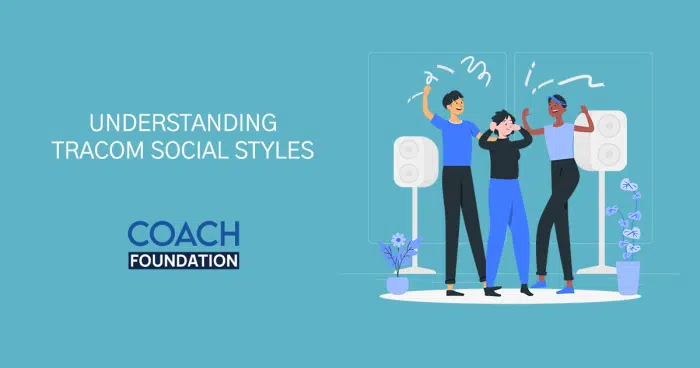Blog » Coaching Models and Techniques » Tracom social styles
Tracom social styles
Regardless of the shape, size, and scope of your organization, one thing remains true – success in today’s competitive business environment requires effective communication. That’s why Tracom’s social styles are increasingly becoming a standard for businesses around the world.
Developed over 40 years ago, and based on decades of research into human behavior theory, it’s no surprise that this popular method has revolutionized how people understand each other within organizations. In this blog post, we will discuss what Tracom’s social styles are all about and how they can help to build better working relationships throughout any organization, and how they can be used to improve interpersonal relationships at work.
What are Tracom’s Social Styles?
Tracom’s Social Styles is a model that identifies the different social behaviors and styles of communication in individuals and groups. Tracom group created the Social Styles model to help people understand their communication tendencies and preferences as well as those of others.
“Social styles are a series of assessments and tools designed by Tracom to enable people to understand the different communication and social behavior dynamics that exist in teams, organizations, and even greater groups.”
Tracom suggests that these behaviors can be divided into four distinct styles, which are Drivers, Analyticals, Expressives, and Amiables. Tracom’s Social Styles allow individuals to better understand their behavior and the behavior of others.
Furthermore, Tracom provides a framework for team-building activities and improved communication by teaching participants how to adapt their approaches in response to various situations as well as recognizing social behavior variations in others. Tracom’s Social Styles help teams become more successful in collaborating and improving performance within the workplace.
The Social Styles Model
The Social Styles Model is a popular framework used by many business professionals to better understand communication and behavior in the workplace. Developed by social psychologist Dr. David Merrill, this comprehensive system relies on four distinct communicative styles: Analyst, Driver, Amiable and Expressive.
Through these categories, individuals can gain insight into how they communicate with colleagues and can also learn how different communication styles are received
in certain contexts.
The Social Styles Model is an invaluable tool for improving interpersonal relationships between employees.It can also promote greater efficiency and productivity as team members discover how to best collaborate with one another’s distinct styles of communication.
The Social Styles Model provides an intuitive way of understanding how best to interact with different individuals. Emphasis is placed on communication styles, behaviors, and strategies to adjust interactions for the highest level of success in any given situation. In understanding social styles, it’s possible to tailor the way you speak, present yourself, and communicate overall depending on who you are interacting with or engaging a group of people.
Scales of Behavior
Tracom’s Social Styles Model provides insight into how different behaviors can be categorized, enabling us to gain an understanding of how people interact and respond in a particular environment. This model identifies two different scales for behavior: assertiveness and responsiveness. Each with its identifying characteristics. Check out this article explaining scales of behavior for a deeper understanding of the topic.
Assertiveness
Assertiveness refers to how actively individuals respond or react when engaged in social interactions. A person who is high in assertiveness will take an active and direct approach, while someone low in assertiveness is more likely to react passively or avoid expressing opinions altogether.
This model helps understand the range of behavior that can be displayed in social situations, as well as learning strategies for maximizing successful interpersonal interactions.
Responsiveness
Responsiveness, as a scale of behavior, is determined by an individual’s desire to collaborate and take into account input from others. It is typically characterized by flexibility and willingness to accommodate other people’s needs. Those who are more responsive may accommodate opposing opinions whereas those who are less responsive prefer to maintain their objectives regardless of other people’s points of view.
Understanding this concept helps people adapt their communication style depending on the company they are in and the personality of their peers and colleagues.
The Four Styles

“Tracom’s Social Styles model includes four styles: Analytical, Amiable, Driving, and Expressive. Each style represents a different approach to communication and interpersonal relationships, with unique strengths and potential areas for development.”
Tracom’s Social Styles model identifies four distinct styles of behavior, each with its own set of values and strategic approach to problem-solving. Let’s dive deeper to understand them one by one.
Driving: Strong-willed and more Emotionally Controlled
Individuals with a strong will combined with greater emotional control tend to adopt this style. They prefer to get tasks done quickly and straightforwardly, are highly task-oriented, and take charge when needed.
They are also direct but not aggressive in communication, have high expectations for themselves and others, and remain goal-focused. Furthermore, such people tend to be assertive, well-prepared and organized, proactive decision-makers with a no-nonsense approach to achieving desired outcomes.
Expressive: Outgoing and Energizing
They tend to be the life of the party and enjoy being around people. They are often the ones who make things happen. If you need someone to get a project off the ground, an expressive is likely your person!
People with this style regularly initiate conversations and often speak in a direct yet lighthearted manner. They can be great problem-solvers as they often come up with creative solutions to difficult tasks. In group settings, expressive brings energy and enthusiasm which keeps things interesting and dynamic.
Amiable: Easygoing and Supportive
Amiability is an essential aspect of successful communication in any workplace. As part of Tracom’s Social Styles Model, Amiable is characterized by its easy-going and supportive nature. People with this style of communication strive to build strong relationships with others through warmth and approachability, often adopting a team mentality toward problem-solving.
Amiable individuals prefer to avoid direct conflict whenever possible, finding indirect methods for settling differences that inspire respect from all parties involved. With its focus on creating positive working environments and encouraging the creative growth of everyone in them, amiable communication is a key factor in the success of companies large and small.
Analytical: Serious and more Exactly
The analytical approach helps classify different individuals into one of four categories based on their behavior. The task-focused Analytical style is composed of serious, exacting, and fact-driven individuals who are results-oriented and seek accuracy in everything they do. They dislike risk-taking and prefer to evaluate facts before making decisions. Individuals who exhibit an Analytical style tend to be systematic, logical, and detail-oriented in their thinking and decision-making.
They place a high value on accuracy and objectivity and may prefer to work independently rather than in a team. Individuals with an Analytical style tend to be reserved and may take longer to process information before responding. They may ask many questions to clarify details and ensure that they have a complete understanding of a situation.
Ultimately, this behavioral model allows for better collaboration by taking into account the social needs of others during interactions that arise in work and everyday life.
Conclusion
Tracom’s social styles model is a great tool for understanding yourself and others. It can help you communicate more effectively, build better relationships, and improve your overall work performance. This helpful tool will give you a deeper understanding of the four social styles and how they interact with each other.
With this knowledge, you’ll be able to communicate better than ever before! It’s impossible to be an effective leader without understanding the social styles of the people you’re trying to lead.
Frequently Asked Questions (FAQs)
As a coach, how can you leverage Tracom’s Social Styles to help your clients?
As a coach, leveraging the social styles provided by Tracom can help you to better understand your clients and assist in creating more tailored plans for them. Here are some ways coaches can leverage this model:
Reflection: Encourage clients to reflect on their communication style and identify areas for improvement. Ask them to consider which social style they tend to exhibit most often and how this impacts their interactions with others.
Feedback: Provide clients with feedback on how their social style comes across to others. Help them understand how their communication style may be perceived by others and how they can adapt their style to build better relationships.
Share: Share the Social Styles model with clients/ teammates and explain how it works. Provide examples of each style and how they tend to communicate, as well as strategies for working effectively with each style.
Aggregate Results: Use the Social Styles model to aggregate results across a team or organization. This can help identify patterns in communication styles and provide insights into how teams can work more effectively together.
By encouraging reflection, providing feedback, and sharing and aggregating results, coaches can help clients develop a more nuanced understanding of how to communicate effectively with others.
What is the aim of the Social Style model?
The social style model emphasizes the importance of adapting one’s communication style to the person they are talking to. With this model, individuals can recognize the different communication styles of others with greater accuracy, allowing them to adjust their own words and behaviors accordingly to maximize effectiveness in engaging with people.
Ultimately, the social style model aims to help people expand their understanding of interactions and develop interpersonal skills that will serve them both personally and professionally.

ABOUT SAI BLACKBYRN
I’m Sai Blackbyrn, better known as “The Coach’s Mentor.” I help Coaches like you establish their business online. My system is simple: close more clients at higher fees. You can take advantage of technology, and use it as a catalyst to grow your coaching business in a matter of weeks; not months, not years. It’s easier than you think.
AS SEEN ON





